SUMMARY
This is AI generated summarization, which may have errors. For context, always refer to the full article.

MANILA, Philippines – When “fine dining” feels like home, you know you’re at Hapag MNL.
Private dining restaurant Hapag MNL aims to serve familiar Filipino flavors using traditional techniques but in new ways, amid a casual, unpretentious atmosphere that welcomes rather than intimidates.

Located along Katipunan Avenue, Quezon City, this small restaurant is founded by friends Chef Thirdy Dolatre, Chef Kevin Navoa, and Chef Kevin Villarica – the brains behind Hapag’s “progressive Filipino cuisine” that highlights local produce from our lands and different flavors from various regions.

“Proud to be Filipino” is what the Hapag team wants each customer to feel once they walk out of Hapag’s doors, buttons slightly bursting and with a newfound appreciation of our country’s culinary heritage. They aim to tell a humble story in each dish, with no details spared. Everything is conceptualized from the Filipino eye – from the kamayan presentation, regional ingredients, to the traditional methods used in each dish.
What to expect: Ambiance, menu, service
Hapag’s dining experience falls in the middle of upscale and fine casual – perfect for special date nights or intimate celebrations where a casual splurge is what you’re looking for. You will feel special, thanks to the attentive and hands-on Hapag staff who know the menu by heart and will be glad to explain each course to you as it’s served.

It’s easy to appreciate the classy yet homey vibe of the place – with its wooden, minimalist interiors and warm lighting, the atmosphere is instantly intimate but comfortable. You’ll also feel the buzzing energy of the open kitchen. It’s a cozy ideal date place that doesn’t feel stiff at all – and interestingly only grew to be as such in the pandemic, according to Chef Kevin Navoa.
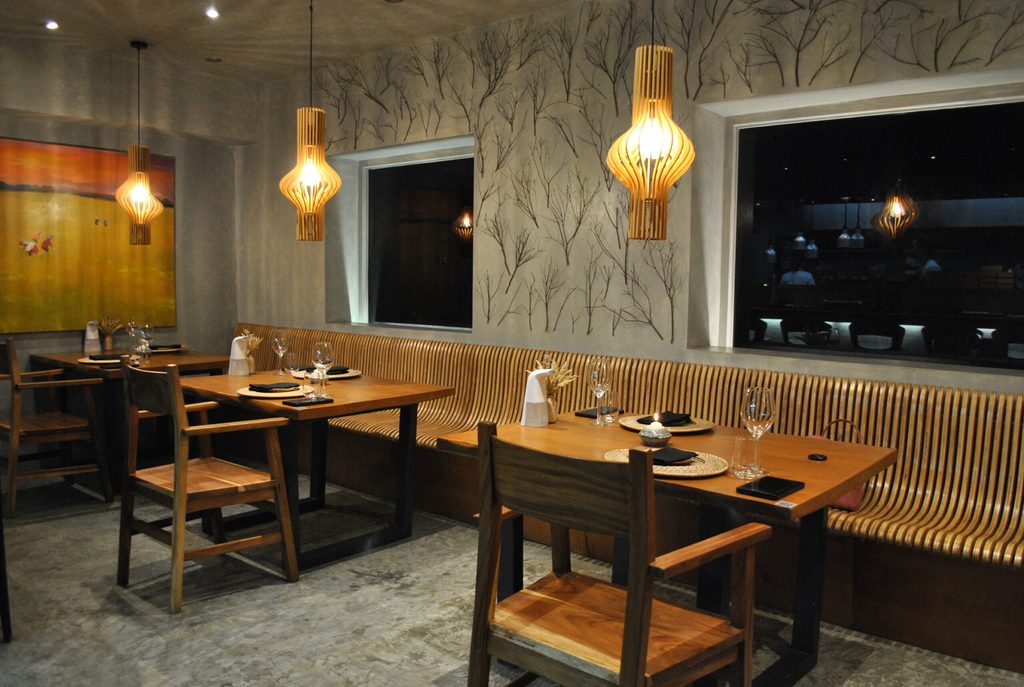
“Pre-pandemic, we could fit four to five people in one table. Since the pandemic, we are only allowed to seat two people. Ngayon, nag-iba yung whole energy and atmosphere of the restaurant. Not as crowded, not as noisy, and puro couples,” Navoa told Rappler. If you’re new to “fine dining,” Hapag makes it a point not to make you feel like you are. It’s like an approachable and hospitable gateway into that world.
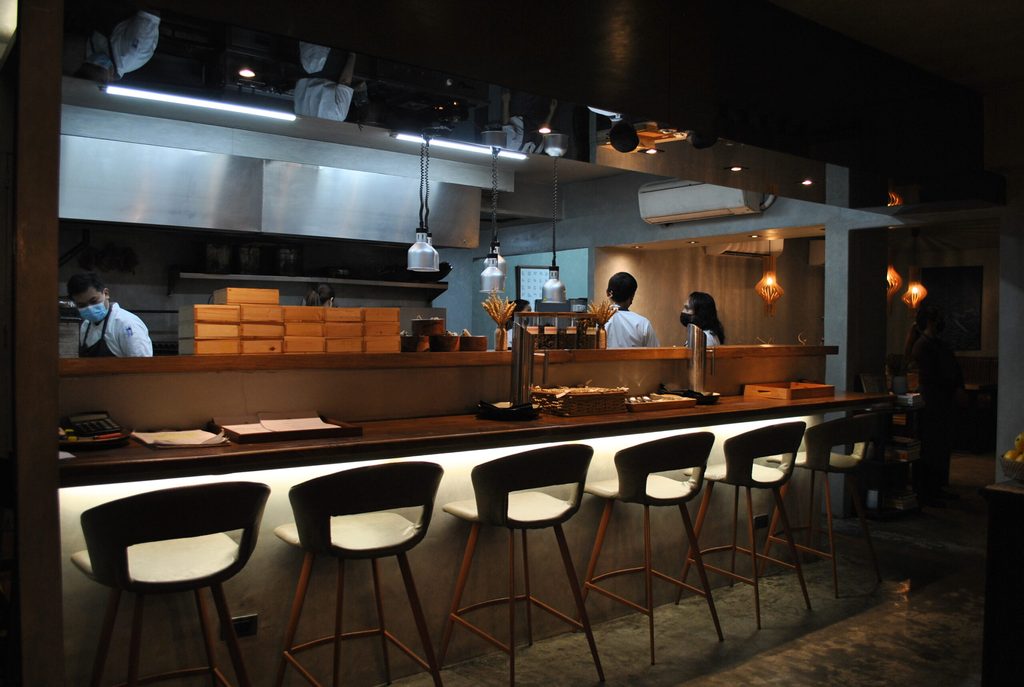
“We try our best to make them feel more at home, rather than they feel stiff. Parang bahay ng Pinoy…. Kapag may bisita ka (Like in any Filipino home, when you have visitors), you want them to feel comfortable. Just feed them really, really well. We try to stick to Filipino values,” Navoa said.
These Filipino values are not only reflected in their service and ambiance, but also in their food. The Hapag menu pays homage to Filipino traditional techniques, local produce, and familiar flavors with an inventive spin, but still with care and respect. The elements and flavors are familiar, but how they’re combined together and presented isn’t, which adds to the curiosity and fun.

They also use a lot of fermentation in their menu – a traditional technique that requires patience, time, care, and hard work. So heads up: if you’re not into fermented foods, like buro, bagoong, or miso, their menu may not be for you, since Hapag uses a lot of these in their dishes. They also use sweet flavor profiles, as a way to still cater to “the palate of the Filipino,” according to Dolatre.
“We just make sure to still understand the palate of the Filipino. You can do anything you want, just make sure pasok siya sa panlasa ng Pinoy. Matamis kasi kumain ang mga Pinoy,” he added.
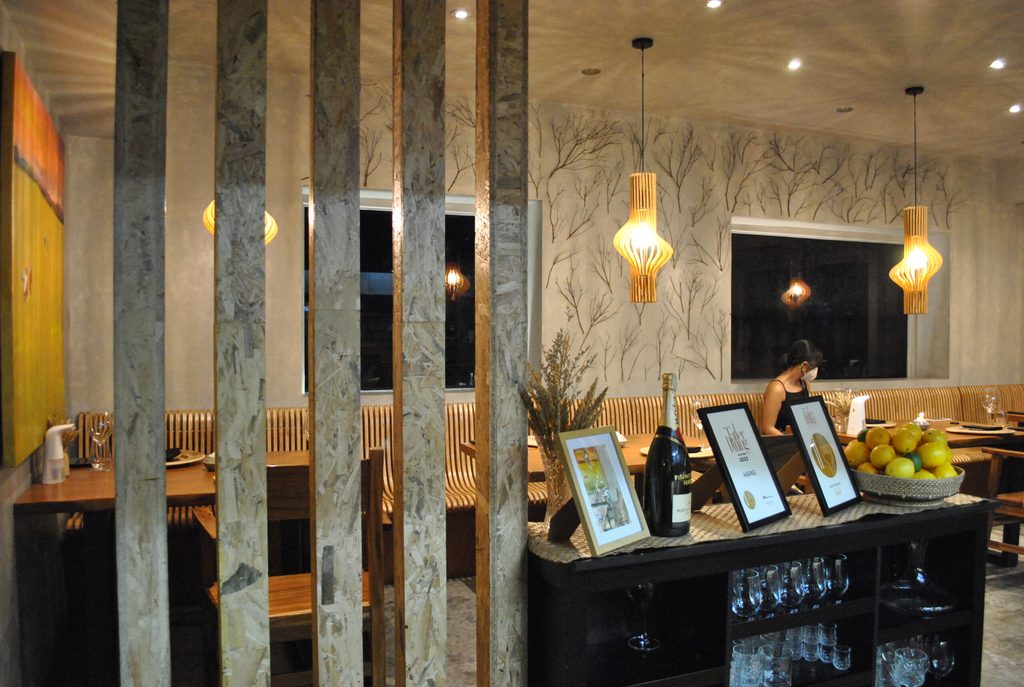
“We try to keep it really Filipino with the ingredients that we use, and traditional techniques from before, like fermentation, like with bagoong and buro,” Navoa said. Hapag prioritizes their fermented babies so much, that they actually have a rack of “living organisms” in their kitchen area.
Fermentation is a time-consuming practice that took them months to learn via reading books and trial and error, but once they got the timings of different food fermentations down pat, it pretty much became what they mainly use to flavor several elements of their dishes. Navoa said their miso can take up to 10 months of fermentation!
“We ferment whatever we can get – from beans, vegetables, everything, and even kamote, which we ferment with buhod (rice wine). The advantage of our flavors is we have these ferments that only we have. We just try to see what makes sense to us. Meron siyang (They have) another layer of flavor that you just don’t get in one day,” Dolatre said.
Of course, it’s all about the courses
We tried Hapag’s ten-course tasting menu for December 2021, which costs P3,500 per head. It’s important to note that Hapag’s tasting menu (no ala carte options here, by the way) changes seasonally, depending on ingredient availability. Some staple Hapag dishes remain as mainstays, while some are replaced by newer ones, and then reintroduced again in the future.
We were seated at 6:30 pm, and I made sure to only have a light lunch to prepare my appetite for the night ahead. Thankfully, Hapag started off the course with some bread (yay, carbs!) as they introduced the Pan De Kalinga.

Hapag’s fermented black rice sourdough is served with slightly salted butter and Palawan honey drizzled on top. The best part, for me, was the fermented sweet potato halaya, topped with shavings of Malagos La Rosita cheese.

This fermented kamote jam was totally my jam – it was creamy, salty, and tangy, made even more savory by the parmigiano-like cheese on top. I never thought I’d enjoy fermented kamote, but it actually makes sense. The sweet-tangy creation worked well with the honey butter, and its jammy texture was good to spread on the chewy-crunchy sourdough.
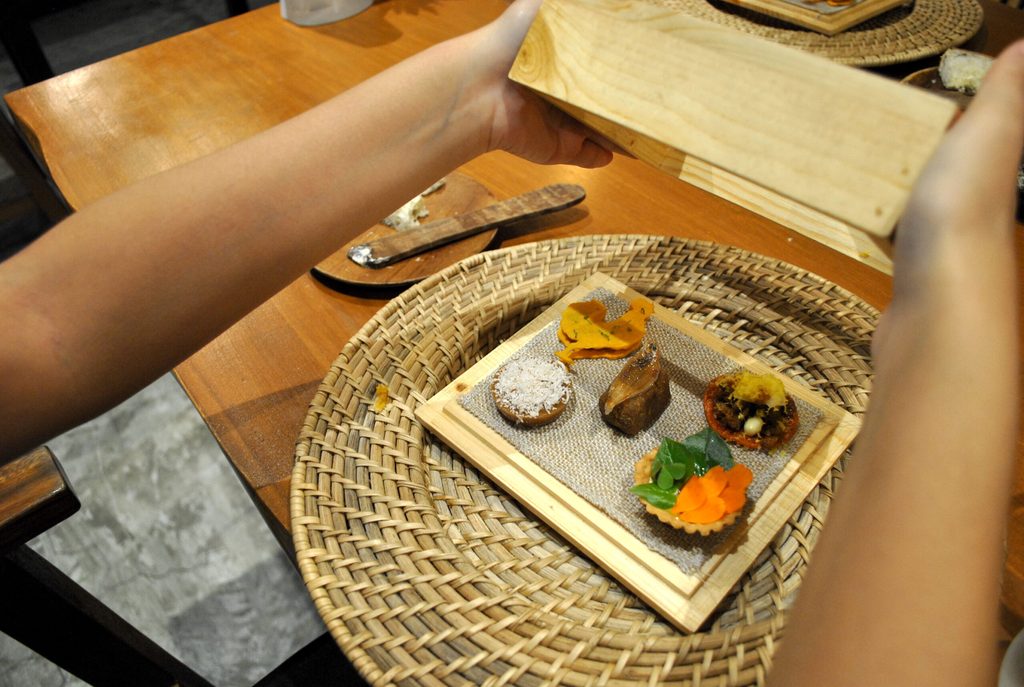
The second appetizer served was Hapag’s cute Snackbox, reminiscent of our childhood chichirya lunch boxes. Each bite-sized “snack” represents classic Filipino delicacies from different regions – there’s a Chicken Inasal Cracker, Champorado at Tuyo, Keso at Kabute Tartlet, Empanada, and Soy Caramel Kutsinta.
The adorable Chicken Inasal Cracker is the lightest snack of the box – delicate, crisp, and thin chicken-shaped tuille sandwiches with an airy, chicken inasal-flavored parfait inside and seasonal jam for a hint of sweetness. The inasal flavor isn’t very prominent, but it’s a good savory cracker to start off the course with.

My favorite from the snack box was the light but flavorful Keso at Kabute Tarlet – a flaky, buttery tart with local oyster mushroom, kesong puti mousse, sukang Iloko jelly, and arnibal. It’s a fresh and cohesive flavor explosion in one bite – you get umami from the mushroom, saltiness from the kesong puti, and acidity from the suka jelly, plus some freshness from the fresh microgreens on top.
Sweet tooths may enjoy the Champorado at Tuyo, made from Auro chocolate and sticky rice, fried into a crisp croquette until chewy on the inside, served with crispy tuyo on top. It does taste just like your household champorado in bite-sized form (just a bit drier and less sweet). Champorado isn’t complete with dried salted fish, but the one used on top wasn’t as salty as I would prefer it to be.
If you like Ilocos empanada, the Empanada snack is a bite-sized but just as tasty take – a crispy rice tostada carries tender, moist pork longganisa, sukang Iloko emulsion, and homemade banana ketchup on top.
Last in the box – and another fave – is the Soy Caramel Kutsinta; a perfect way to end the snackbox experience on a sweet note. It’s a melt-in-your-mouth piece of kutsinta made with kadios shoyu and topped with grated fresh coconut. The treat tasted like a slightly salted burnt caramel that’s decadent and sweet. Since it was kutsinta, I was expecting it to be gummier and chewier, but I appreciated the interesting pudding-like consistency.
The next course was Hapag’s Kinilaw na Malasugi sa Pakwan. Say “kinilaw” and I’ll be there in a heartbeat! Hapag’s version of the regional delicacy featured local blue marlin, bathed in a citrus dressing and swimming in a sweet watermelon consommé, topped with fresh micro greens and spring onion oil.

The fish was tender, soft, undeniably fresh, and very delicate. However, it’s not like your typical “babad sa suka” kilawin – the citrus dressing is fruity, and the watermelon broth was actually very sweet and strong, which was new to me. Personally, I prefer my kilawin on the sour side with no sweetness, but it was a pleasantly refreshing and simple seafood appetizer on its own.
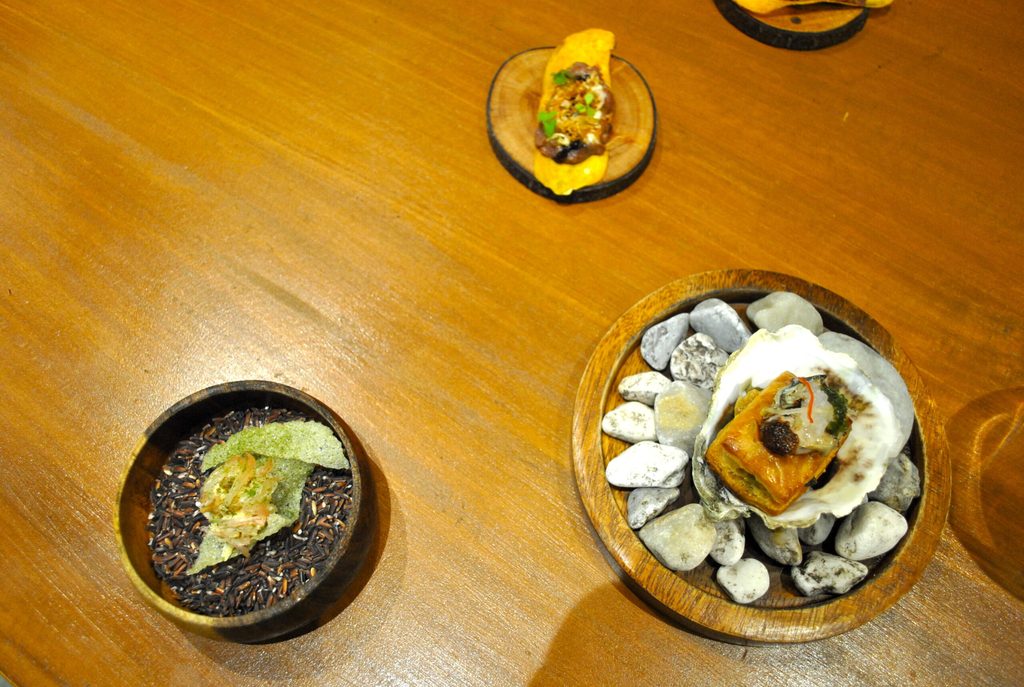
Next was the LuzViMinda – a play on Luzon, Visayas, and Mindanao – and Hapag’s effort to promote a slice of each region in one course. The three plates are served on your table according to the Philippine map (props for details)!

Luzon was represented by the Kilawing Baka that melts in your mouth. This Philippine version of a steak tartare is mixed with fermented mustard seeds and pickled gamet, a traditional dried seaweed from Ilocos Norte. The Visayas representative, though, was my favorite – the Oyster Napoleones – which was a dish that I would love to have again as an ala carte order.

You get the signature puff pastry of Bacolod, topped with a juicy, fresh Iloilo oyster, smoked eggplant ensalada, and kadios miso glaze. In one bite you get the buttery richness of oyster, the sweetness of napoleones and eggplant ensalada, and the salty tang of kadios miso. The sweet pastry helps to cut through the richness of oyster, but the Iloilo shellfish still remains the star.
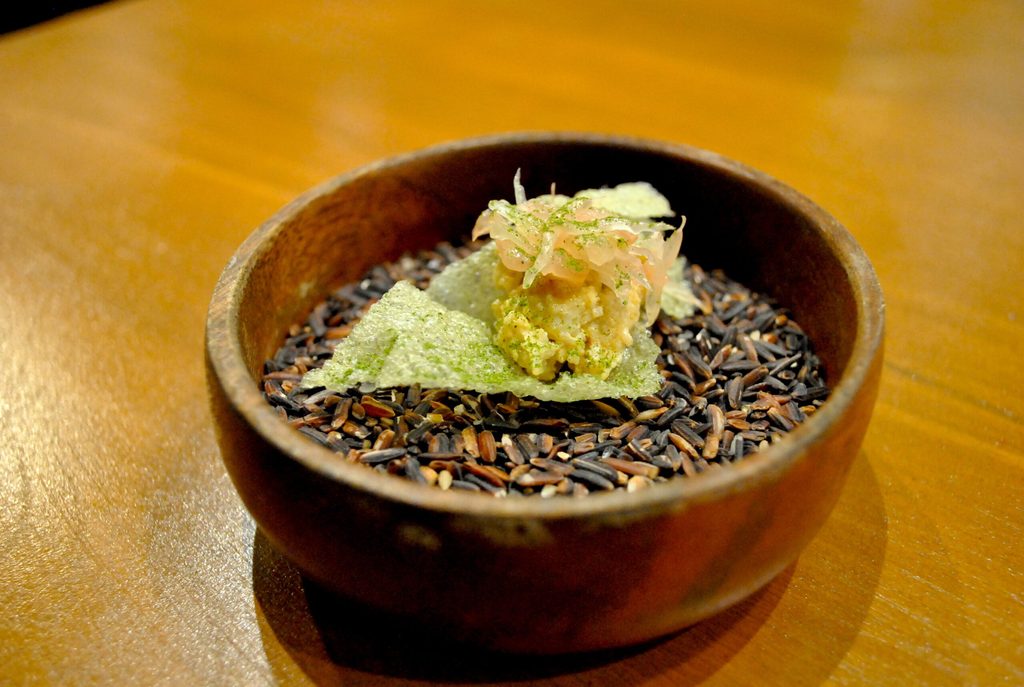
Mindanao’s was the Crab Alavar – a crisp seaweed cracker with crab salad, alavar sauce (coconut milk, taba ng talangka), pineapple palapa jam (Lanao Del Sur’s sweet-spicy condiment), and Davao pomelo in one bite. It was a bit underwhelming for me out of all three (I was looking for more crab fat); but maybe it was because its predecessor – the flavor bomb of Visayas – was hard to beat.
The next course was my favorite of the whole evening (and a favorite of Chef Thirdy’s as well) – the Inihaw na Sugpo sa Miso. It’s a simple but memorable dish of grilled prawn with a dayap-munggo miso glaze, fresh veggies, tomato jam, pineapple labuyo jam, and house fermented buro.

The shrimp itself was well-cooked and tender; its taste was fresh, light, and perfectly tangy and savory (thanks to the dayap), with an umami kick because of the addictive miso glaze. You can have it with the buro on the side – chunky, salty, and slightly sour.

The shrimp (which I wish there was another piece of) is served with greens, so feel free to wrap it in a leaf with the papaya relish for a fresh bite. The jams on the side are optional – they add sweetness and some spice if you’re looking for those flavors – but I didn’t need them, personally. The taste was already on point on its own.
Next was the Laing Stones, a popular dish of Hapag that’s remained a staple on their menu. It had the most interesting presentation – the laing stones are served among hot rocks and edible leaves inside a clay cauldron.

The stones are sprayed with mango rum at your table, which was honestly more for interactive presentation, as I didn’t really taste it in the burnt coconut-battered laing balls, which were served with a slice of burong mangga on top for some pickled tang and a slight crunch.

The laing ball is crunchy on the outside and soft and chewy and on the inside. It’s an unconventional, new way to enjoy the classic, well-loved Bicolano veggie dish, but taste-wise, it didn’t really veer away from the usual laing you have at home – which isn’t necessarily a bad thing! But if you’re looking for a new twist to laing, it’s not very present here.
Next was the Uni Arroz Caldo – something I got excited about because I love sea urchin in all forms! The gorgeous, colorful dish features adlai arroz caldo, tinapa, uni cream, spring onion oil, puffed rice, and bihod bottarga (crunchy cured fish roe).

Texture-wise, I enjoyed the arroz caldo using adlai, which transformed the usually mushy stew into one with more of a bite. The extra toppings (puffed rice, bihod bottarga) added a welcome crunch, but I was hoping for more uni oomph. The uni cream was very light, so I was looking for more of the uni’s distinct saltiness and richness in the dish. It was flavorful, though, thanks to the tinapa, but I was also looking for a citrusy zing to cut through the saltiness, just like how calamansi can instantly elevate an arroz caldo.

The palate-cleanser course – Mango Sorbetes – came at the perfect time. The homemade Guimaras mango sorbet is one of the best that I’ve had (and really wish I could take home a pint)! It was very tangy, smooth, sweet, and incredibly refreshing. It’s served with chilimansi powder for an extra zing of tang, spice, and everything nice.

The main event of Hapag’s course menu is the Salu-Salo, a feast fit for a hungry group. Freshly-steamed pandan rice is served in a traditional palayok, alongside the three mains: Duck Estopato, tender, dry-aged Cavite duck breast with crispy skin and estofado sauce that’s slightly sweet; and Inihaw na Baboy, 24-hour grilled pork belly with kanto inihaw sauce that’s familiarly sweet and savory. The perfectly grilled pork is fork-tender and soft; you won’t need a knife to cut through this luscious cut of meat.
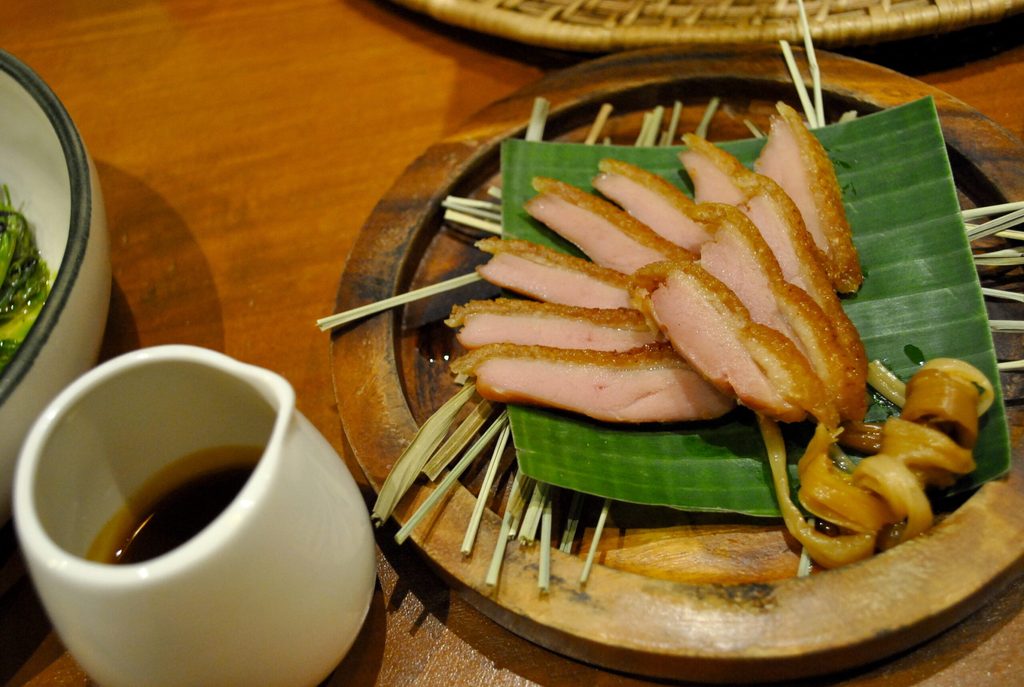

My favorite was the Pinasingaw na Lapu-Lapu – steamed grouper covered in black bean miso. The miso is very fermented, so it’s salty and strong, but it goes well with the fresh, flaky, tender fish and crisp leeks, and makes for a flavorful seafood entree that’s great with rice.

It works best with the refreshing veggie side dishes, too – pair it with either the grilled pako salad with kamias, jackfruit vinaigrette, and spring onion oil; pickled mustasa; or mango ensalada, and you’ve got yourself a filling meal with a variety of flavors.

At this point, I was already approaching food comatose status, but there is always room for dessert! Hapag’s Ginanggang Ice Cream used very ripe bananas for their creamy, thick black banana ice cream, topped with Auro Chocolate nibs, Benguet coffee oil, meringue, and banana streusel. Local banana is the star of this show, and is complemented by the dollops of meringue and streusel that add an addictive, sweet crunch.

Last but not least is the crowd-favorite Chocnut dessert – Auro chocolate is mixed with Chocnut cremeaux and cacao-koji soil, and topped with crispy sea salt chocolate barquillos. If you love dark chocolate and sea salt, plus the choco-peanut childhood candy, this dessert will be the best cap to a satisfying evening.
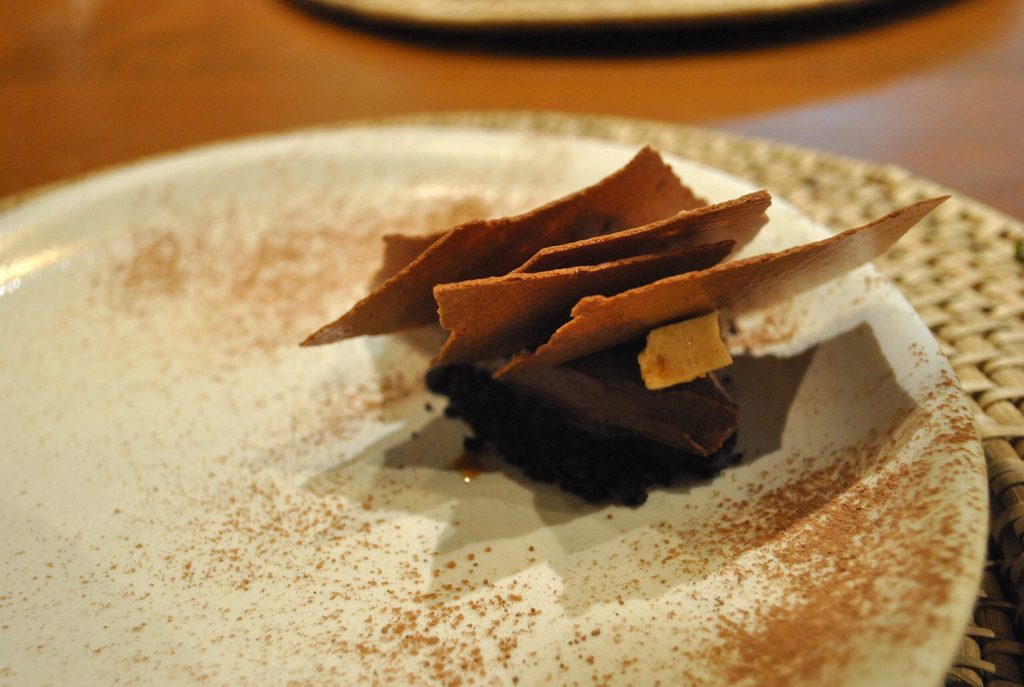
It may sound like a lot, but the serving sizes of each dish were small enough that at the end of dinner, I was satisfied but not so full to the point of feeling bloated. It was a fun experience to share with a friend, especially since we’re both adventurous ~foodies~ and into fermented Filipino side dishes and fresh seafood. However, there is also a prominence of sweet notes, which I didn’t particularly fawn over, since I’m not into sweet Filipino dishes in general. There’s also a repeat of the fermented tastes in some dishes.
But Hapag does what it generally intends to do – shine a light on the country’s best local produce, ingredients, and regional cooking methods through beautiful dishes that combine different flavors that work cohesively. Each element is well thought out of and of high quality.
“At Hapag, we are basically doing Filipino food, but just pushing the boundaries of what it can actually be,” Navoa said, but at the same time, still paying tribute to the best of Philippine produce and ingredients in a creative, ingenuous, but still humble way. – Rappler.com
Hapag MNL is open from Thursday to Sunday for dine-in customers, from 5:30 pm to 10:00 pm. They’re located along Katipunan Ext, 201 Katipunan Ave, Project 4, Quezon City.
Add a comment
How does this make you feel?





There are no comments yet. Add your comment to start the conversation.